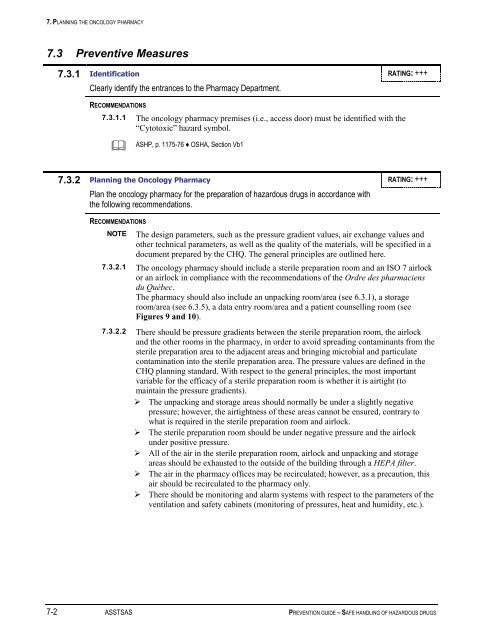Prevention Guide - Safe Handling of Hazardous Drugs - Irsst
Prevention Guide - Safe Handling of Hazardous Drugs - Irsst
Prevention Guide - Safe Handling of Hazardous Drugs - Irsst
You also want an ePaper? Increase the reach of your titles
YUMPU automatically turns print PDFs into web optimized ePapers that Google loves.
7. PLANNING THE ONCOLOGY PHARMACY<br />
7.3 Preventive Measures<br />
7.3.1 Identification RATING: +++<br />
Clearly identify the entrances to the Pharmacy Department.<br />
RECOMMENDATIONS<br />
7.3.1.1 The oncology pharmacy premises (i.e., access door) must be identified with the<br />
“Cytotoxic” hazard symbol.<br />
<br />
ASHP, p. 1175-76 ♦ OSHA, Section Vb1<br />
7.3.2 Planning the Oncology Pharmacy RATING: +++<br />
Plan the oncology pharmacy for the preparation <strong>of</strong> hazardous drugs in accordance with<br />
the following recommendations.<br />
RECOMMENDATIONS<br />
NOTE<br />
The design parameters, such as the pressure gradient values, air exchange values and<br />
other technical parameters, as well as the quality <strong>of</strong> the materials, will be specified in a<br />
document prepared by the CHQ. The general principles are outlined here.<br />
7.3.2.1 The oncology pharmacy should include a sterile preparation room and an ISO 7 airlock<br />
or an airlock in compliance with the recommendations <strong>of</strong> the Ordre des pharmaciens<br />
du Québec.<br />
The pharmacy should also include an unpacking room/area (see 6.3.1), a storage<br />
room/area (see 6.3.5), a data entry room/area and a patient counselling room (see<br />
Figures 9 and 10).<br />
7.3.2.2 There should be pressure gradients between the sterile preparation room, the airlock<br />
and the other rooms in the pharmacy, in order to avoid spreading contaminants from the<br />
sterile preparation area to the adjacent areas and bringing microbial and particulate<br />
contamination into the sterile preparation area. The pressure values are defined in the<br />
CHQ planning standard. With respect to the general principles, the most important<br />
variable for the efficacy <strong>of</strong> a sterile preparation room is whether it is airtight (to<br />
maintain the pressure gradients).<br />
‣ The unpacking and storage areas should normally be under a slightly negative<br />
pressure; however, the airtightness <strong>of</strong> these areas cannot be ensured, contrary to<br />
what is required in the sterile preparation room and airlock.<br />
‣ The sterile preparation room should be under negative pressure and the airlock<br />
under positive pressure.<br />
‣ All <strong>of</strong> the air in the sterile preparation room, airlock and unpacking and storage<br />
areas should be exhausted to the outside <strong>of</strong> the building through a HEPA filter.<br />
‣ The air in the pharmacy <strong>of</strong>fices may be recirculated; however, as a precaution, this<br />
air should be recirculated to the pharmacy only.<br />
‣ There should be monitoring and alarm systems with respect to the parameters <strong>of</strong> the<br />
ventilation and safety cabinets (monitoring <strong>of</strong> pressures, heat and humidity, etc.).<br />
7-2 ASSTSAS PREVENTION GUIDE – SAFE HANDLING OF HAZARDOUS DRUGS

















